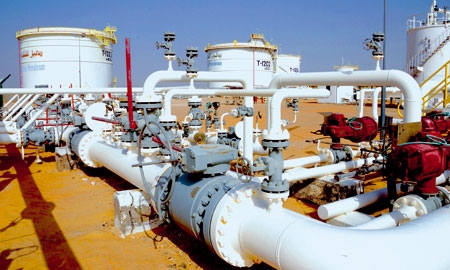Oman’s deposits of 4.9 billion barrels of crude oil and 849.5 cubic metres of natural gas place the sultanate 25th and 27th globally in terms of proven reserves. A mature oil producer, with explorations dating back to the 1950s, and the largest in the Middle East who is not a member of OPEC, its available deposits may be on the decline and dwarfed by those in neighbouring Saudi Arabia, United Arab Emirates and Qatar, but they are nevertheless significant. In 2012, hydrocarbons accounted for 86 per cent of government revenues and around half of total GDP. Furthermore, increasing challenges to their extraction have spurred innovative new methods in the industry and added impetus to raising Omani skill sets and the push for economic diversification.
Unlike its neighbours with giant, fluid lakes of oil under their soils, Oman’s oil reserves are more likely to be held in scattered, smaller fields, which age quickly and leave thick, sticky crude that until recently needed expensive technology to extract. Such characteristics led to oil production falling by more than 26 per cent between 2000 and 2007, from 972,000 barrels per day (bpd) to 714,800 bpd. However, Oman has since been referred to as the “comeback kid of the oil world” as its willingness to innovate and test frontier technologies has returned the industry to former production levels.
“We seek overseas investments that can be linked back to Oman, bringing with them value and knowledge transfer into the country” Mulham Al Jarf,
Deputy CEO of Oman Oil Company (OOC) |
“Oman is a small producer when you take global production into account, with about 950,000 barrels a day. We could reach a million, but the most important thing is to reach a level of production which is sustainable,” says Nasser bin Khamis Al Jashmi, Undersecretary at the Ministry of Finance and Chairman of Oman Oil Company (OOC). “We are trying to reduce costs by applying the latest technologies and streamlining operations.”
Mr Al Jashmi highlights the industry’s application of unconventional extraction techniques such as hydraulic fracturing – or fracking – and injecting liquid polymers into heavy-oil fields to force the crude out as a major part of its upswing. “We have found in many cases costs are going down as we learn how to drill more efficiently; in some cases costs have fallen by 50 per cent,” he adds.
Enhanced oil recovery (EOR) techniques are vital to the industry’s future. Petroleum Development Oman (PDO) – a 60 per cent government-owned joint venture that produces 70 per cent of the country’s oil output and accounts for almost all of Oman’s natural gas supply – is a major proponent of their development. PDO expects 16 per cent of its oil production to come from EOR projects by 2016, up from just 3 per cent in 2012. It is also investing heavily in training Omanis in EOR and helping the country to be a future exporter of expertise in the sector.
“The experience in having to deal with complex and unconventional reservoirs has allowed Oman to uniquely develop specialist niche expertise in this field that has the potential to be exported,” says Mulham Al Jarf, Deputy CEO of OOC, the country’s flagship energy investment firm, which established a human capital development unit – Takatuf – in 2010. “Today, what we see in Oman that still remain untapped are complex and often unconventional and deep reservoirs. In order for OOC to grow its Omani production base and reserves, it will need to tackle such reservoirs.”
“We have no geographic restrictions,” adds Mr Al Jarf. “As a rule of thumb, we seek overseas investments that can be linked back to Oman, bringing with them value and knowledge transfer into the country.”
OOC is also an active contributor to Oman’s In Country Value (ICV) initiative, which “plays a key role in unlocking economic potential in Oman as well as helping to create a sustainable economic base,” says Mr Al Jarf. “The successful long-term development of SMEs has proven time and time again in many countries to be the engine that drives the economy.”
The company heavily invests in energy and energy-related sectors, which are broadly categorised as: exploration and production (E&P), refining and marketing, base petrochemicals, specialty chemicals, infrastructure, power, shipping, and metals and mining. Its E&P arm, OOCEP, has a 40 per cent stake in a new fracking project at the Khazzan field with BP, which received the green light from the government in December. Construction on the $16 billion development starts this year and it is expected to produce at least 1 billion cubic feet of gas per day, starting in late 2017, raising the country’s current output by around one-third. In addition, OOC and BP have signed a memorandum of understanding to develop the world’s first acetic acid manufacturing plant using BP’s new SaaBre™ process.
“As we invest for the future, perhaps the most important part of our investment is investing in the people who go with the plans and operations for many decades,” says David Dalton, Regional President Middle East at BP. “There will be a need to continually look for the more difficult hydrocarbons. But with the right investment climate and incentives for foreign investment, and the right encouragement and framework set by the ministry, I am optimistic that will happen.” ●

0 COMMENTS